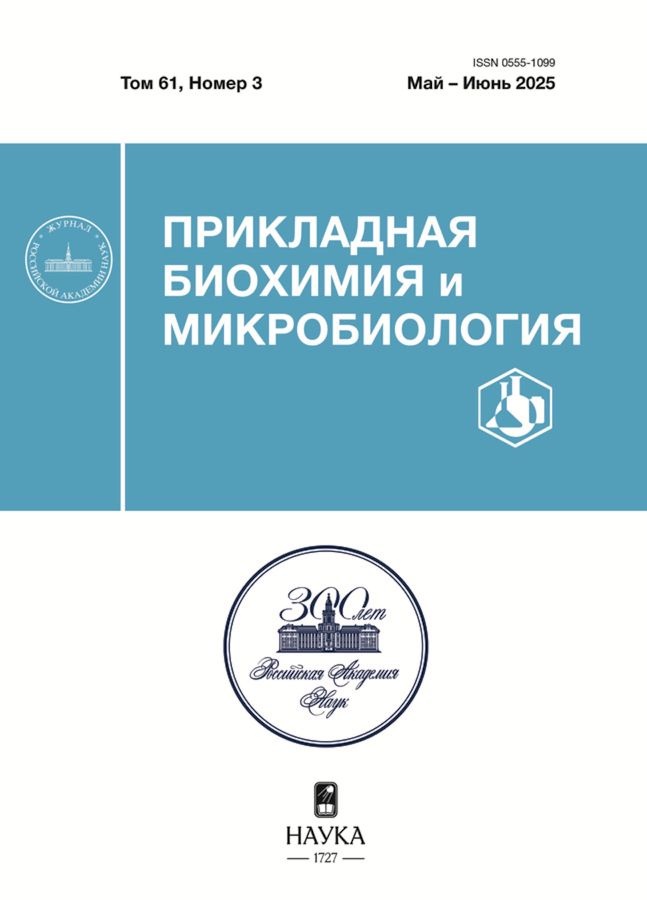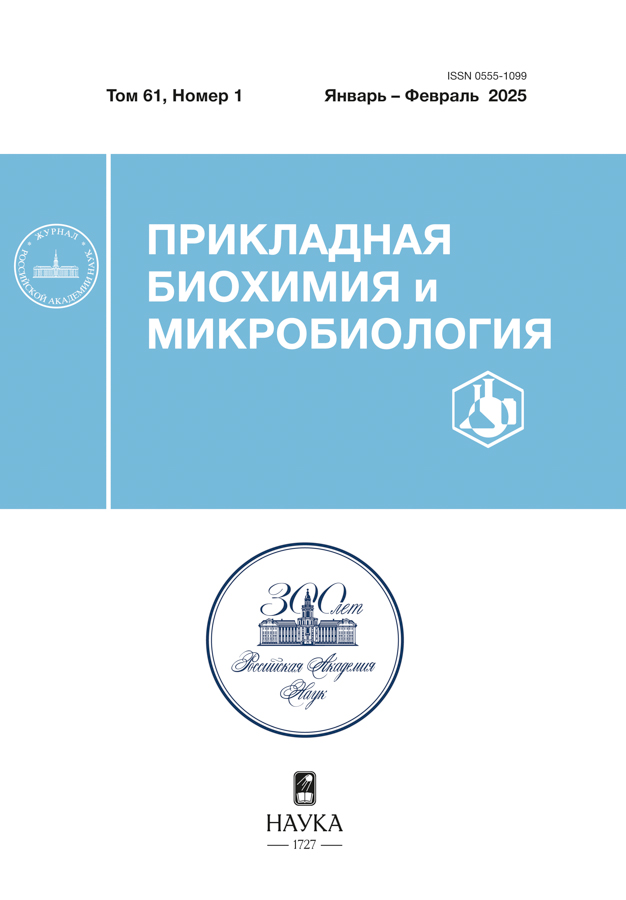Новые агрономически ценные штаммы рода Streptomyces и их биохимическая характеристика
- Авторы: Широких И.Г.1,2, Боков Н.А.1,2, Алалыкин А.А.2, Широких А.А.1,2
-
Учреждения:
- Федеральный аграрный научный центр Северо-Востока имени Н.В. Рудницкого
- Вятский государственный университет
- Выпуск: Том 61, № 1 (2025)
- Страницы: 89-99
- Раздел: Статьи
- URL: https://medjrf.com/0555-1099/article/view/683315
- DOI: https://doi.org/10.31857/S0555109925010096
- EDN: https://elibrary.ru/DAHXMX
- ID: 683315
Цитировать
Полный текст
Аннотация
Органическое земледелие — мировой тренд, благодаря которому увеличивается спрос на биологические препараты для использования в сельскохозяйственном производстве. В работе охарактеризованы новые штаммы актиномицетов, изолированные методом прямого высева из почвенных проб, отобранных в различных агроценозах Вятско-Камского Предуралья (Россия). В результате предварительного тестирования (около 350 штаммов) по признаку антифунгальной активности выделены изоляты 8Al3, N27-25 и P15-2, идентифицированные по данным анализа 16S рРНК как бактерии рода Streptomyces. Активное вещество с антифунгальным эффектом — скопафунгин идентифицировано с использованием ВЭЖХ-МС/МС. Наряду с угнетающим действием на фитопатогенные грибы, эти штаммы продуцируют в присутствии 100 мкг/мл L-триптофана ауксины (17.4–20.8 мкг/мл), обладают целлюлолитической активностью и оказывают стимулирующее действие на всхожесть и накопление сухой биомассы проростками пшеницы, клевера и горчицы. Сделано заключение, что обладая комплексом полезных для растений характеристик, штаммы Streptomyces 8Al3, N27-25 и P15-2 могут быть использованы в качестве кандидатных для создания биологических препаратов фунгицидного и фитостимулирующего действия.
Ключевые слова
Полный текст
Об авторах
И. Г. Широких
Федеральный аграрный научный центр Северо-Востока имени Н.В. Рудницкого; Вятский государственный университет
Автор, ответственный за переписку.
Email: irgenal@mail.ru
Россия, Киров, 610007; Киров, 610000
Н. А. Боков
Федеральный аграрный научный центр Северо-Востока имени Н.В. Рудницкого; Вятский государственный университет
Email: irgenal@mail.ru
Россия, Киров, 610007; Киров, 610000
А. А. Алалыкин
Вятский государственный университет
Email: irgenal@mail.ru
Россия, Киров, 610000
А. А. Широких
Федеральный аграрный научный центр Северо-Востока имени Н.В. Рудницкого; Вятский государственный университет
Email: irgenal@mail.ru
Россия, Киров, 610007; Киров, 610000
Список литературы
- The World of Organic Agriculture. Statistics and Emerging Trends 2024. /Eds. H. Willer, J. Trávníček, S. Schlatter. Research Institute of Organic Agriculture FiBL, Frick, and Bonn. IFOAM — Organics International, 2024. 352 p.
- Pérez-Montaño F., Alías-Villegas C., Bellogín R.A., del Cerro P., Espuny M.R., Jiménez-Guerrero I. et al. // Microbiol. Res. 2014. V. 169. P. 325–336. https://doi.org/10.1016/j.micres.2013.09.011
- Basu A., Prasad P., Das S.N., Kalam S., Sayyed R.Z., Reddy M.S., El Enshasy H. // Sustainability. 2021. V. 13. P. 1–20. https://doi.org/10.3390/su13031140
- Seipke R.F., Kaltenpoth M., Hutchings M.I.//FEMS Microbiol. Rev. 2012. V. 36. P. 862–876. https://doi.org/10.1111/j.1574-6976.2011.00313.x
- Bonaldi M., Chen X., Kunova A., Pizzatti, C., Saracchi M., Cortesi P.// Front. Microbiol. 2015 V. 6. P. 25. https://doi.org/10.3389/fmicb.2015.00025
- Javed Z., Tripathi G. D., Mishra M., Dashora K.// Biocatal. Agric. Biotechnol. 2021. V. 31. Р. 101893. https://doi.org/10.1016/j.bcab.2020.101893
- Павлюшин В.А., Новикова И.И., Бойкова И.В. // Сельскохозяйственная биология. 2020. Т. 55. №. 3. С. 421–438. https://doi.org/10.15389/agrobiology.2020.3.421rus
- Cordovez V., Carrion V. J., Etalo D.W., Mumm R., Zhu H., van Wezel, G.P., Raaijmakers J.M. // Front. Microbiol. 2015. V. 6. P. 1081. https://doi.org/10.3389/fmicb.2015.01081
- Viaene T., Langendries S., Beirinckx S., Maes M., Goormachtig S. // FEMS Microbiol. Ecol. 2016. V. 92. № 8. https://doi.org/10.1093/femsec/fiw119
- Basic Biology and Applications of Actinobacteria. / Ed. Enany S. (Ed.). IntechOpen, 2018. P. 99–122.
- Vurukonda S.S. K.P., Giovanardi D., Stefani E. // Int. J. Mol. Sci. 2018. V. 19. №. 4. P. 952. https://doi.org/10.3390/ijms19040952
- Pacios-Michelena S., Aguilar Gonzalez C.N., Alvarez-Perez O.B., Rodriguez-Herrera R., Chávez-González M., Arredondo Valdes R., Ilyina A. // Front. Sustain. Food Syst. 2021. V. 5. P. 696518. https://doi.org/10.3389/fsufs.2021.696518
- Rey T., Dumas B. // Trends in Plant Science. 2017. V. 22. №. 1. P. 30–37. https://doi.org/10.1016/j.tplants.2016.10.008
- Suprapta D.N. // J. ISSAAS. 2012. V. 18. №. 2. P. 1–8.
- Широких И.Г., Бакулина А.В., Назарова Я.И., Широких А.А., Козлова Л.М. // Микология и фитопатология. 2020. Т. 54. № 1. С. 59–66. https://doi.org/10.31857/S0026364820010080
- Komaki H., Tamura T. // Int. J. Syst. Evol. Microbiol. 2020. V. 70. P. 1099–1105. https://doi.org/10.1099/ijsem.0.003882
- Shirling E.B., Gottlieb D. // Int. J. Syst. Bacteriol. 1966. V. 16. P. 313–340. https://doi.org/10.1099/00207713-16-3-313
- Tamura K., Stecher G., Kumar S. // Mol. Biol. Evol. 2021. V. 38. № 7. P. 3022–3027. https://doi.org/10.1093/molbev/msab120
- Гаузе Г.Ф., Преображенская Т.П., Свешникова М.А., Терехова Л.П., Максимова Т.С. Определитель актиномицетов. М.: Наука, 1983. 245 с.
- Ryan M.C., Stucky M., Wakefield C., Melott J.M., Akbani R., Weinstein J.N., Broom B.M. // F1000Res. (ISCB Comm J). 2019. V. 8. P. 1750. https://doi.org/10.12688/f1000research.20590.2
- Ghose T.K. // Pure & Appl. Chem. 1987. V. 59. № 2. P. 257–268.
- Song X., Yuan G., Li P., Cao S. // Molecules. 2019. V. 24. P. 3913. https://doi.org/10.3390/molecules24213913
- Wang Z., Gao C., Yang J., Du R., Zeng F., Bing H., Liu C. // Front. Microbiol. 2023. V. 14. P. 1243610. https://doi.org/10.3389/fmicb.2023.1243610
- Kim H.Y., Kim J.D., Hong J.S., Ham J.H., Kim B.S. // J. Basic. Microbiol. 2013. V. 53. P. 581–589. https://doi.org/10.1002/jobm.201200045
- Reusser F. // Biochem. Pharmacol. 1972. V. 21. P. 1031–1038. https://doi.org/10.1016/0006-2952(72)90408-x
- Mogi T., Matsushita K., Murase Y., Kawahara K., Miyoshi H., Ui H. et al. // FEMS Microbiol. Lett. 2009. V. 291. P. 157–161. https://doi.org/10.1111/j.1574-6968.2008.01451.x
- Nakayama K., Yamaguchi T., Doi T., Usuki Y., Taniguchi M., Tanaka T. // J. Biosci. Bioeng. 2002. V. 94. P. 207–211. https://doi.org/10.1263/jbb.94.207
- Fei P., Yang X., Lu-jie C., Hong J., Yun-yang L. // Natural Product Research & Development. 2011. V. 23. № 5. P. 809–814.
- Fei P., Wenzhou Z., Yangjun L., Yuee Z., Ping L., Yiwen Z., Linlin C. // Genome-based Analysis for the Biosynthetic Potential of Streptomyces sp. FIM 95-F1 Producing Antifungal Antibiotic Scopafungin. 2023. https://doi.org/10.21203/rs.3.rs-3052084/v1
Дополнительные файлы















